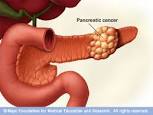“Poria cocos is a medicinal mushroom that is widely used in traditional Asian medicine. Here, we show that a characterized mixture of triterpenes extracted from P. cocos (PTE) and three purified triterpenes: pachymic acid (PA), dehydropachymic acid (DPA) and polyporenic acid C (PPAC) suppress the proliferation of the human pancreatic cancer cell lines…
Moreover, the most effective compound, PA, only slightly affects the proliferation of HPDE-6 normal pancreatic duct epithelial cells.
In conclusion, triterpenes from P. cocos demonstrate anticancer and anti-invasive effects on human PC cells and can be considered as new therapeutic agents in the treatment of pancreatic cancer.”
“The key to curing the type of PC that afflicted Apple visionary Steve Jobs just might be found in an ancient Chinese herb that has long played a crucial role in traditional Chinese medicine. A new study published in the journal Science Translational Medicine has revealed that lei gong teng, also known as “thunder god vine,” possesses at least one unique compound capable of fully eradicating cancer tumors within 40 days, which could eventually make the herb a go-to alternative for treating cancer…
The lei gong teng compound believed to be primarily responsible for killing cancer tumors is triptolide, an active diterpenoid that has been shown in several previous studies to exhibit broad anti-cancer activity. The team was able to effectively isolate this triptolide and convert it into a water soluble form, which researchers then injected into the mice regularly for a little more than one month, which was enough to cure the animals’ cancers…”



